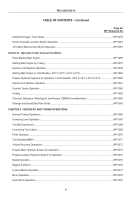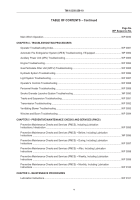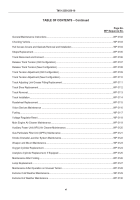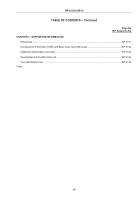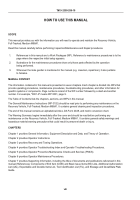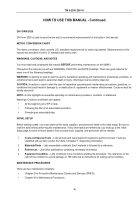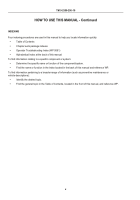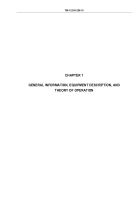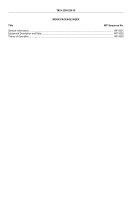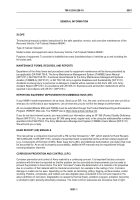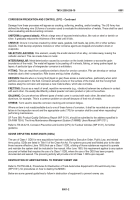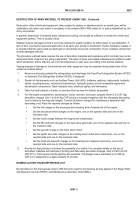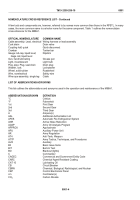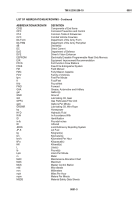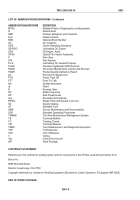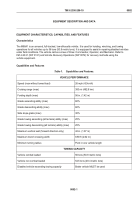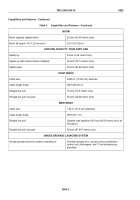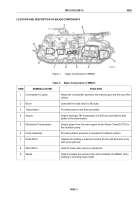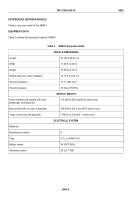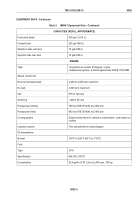TM-9-2350-256-10 - Page 30 of 796
CORROSION PREVENTION AND CONTROL (CPC) - Continued
Damage from these processes will appear as cracking, softening, swelling, and/or breaking. The US Army has
defined the following nine (9) forms of corrosion used to evaluate the deterioration of metals. These shall be used
when evaluating and documenting corrosion.
UNIFORM (or general attack):
Affects a large area of exposed metal surface, like rust on steel or tarnish on
silver. It gradually reduces the thickness of the metal until it fails.
CREVICE:
Occurs in crevices created by rubber seals, gaskets, bolt heads, lap joints, dirt or other surface
deposits. It will develop anywhere moisture or other corrosive agents are trapped and unable to drain or
evaporate.
SELECTIVE LEACHING:
One element, usually the anodic element of an alloy, corrodes away, leaving the
cathodic element. This can create holes in metal.
INTERGRANULAR:
Metal deterioration caused by corrosion on the bonds between or across the grain
boundaries of the metal. The metal will appear to be peeling off in sheets, flaking, or being pushed apart by
layers. A particular type of intergranular corrosion is exfoliation.
PITTING:
This can result from conditions similar to those for crevice corrosion. Pits can develop on various
materials due to their composition. Rifle boxes are big victims of pitting.
EROSION:
Results when a moving fluid (liquid or gas) flows across a metal surface, particularly when solid
particles are present in the fluid. Corrosion actually occurs on the surface of the metal, but the moving fluid
washes away the corrosion and exposes a new metal surface, which also corrodes.
FRETTING:
Occurs as a result of small, repetitive movements (e.g., vibration) between two surfaces in contact
with each other. It’s usually identified by a black powder corrosion product or pits on the surface.
GALVANIC:
Occurs when two different types of metal come in contact with each other, like steel bolts on
aluminum, for example. This is a common problem on aircraft because of their mix of metals.
STRESS:
Term used to describe corrosion cracking and corrosion fatigue.
Where an item is not ready/available due to one of these forms of corrosion, it shall be recorded as a corrosion
failure in the inspection record and the appropriate code (170) for corrosion shall be used when requesting/
performing maintenance.
SF Form 368, Product Quality Deficiency Report (WP 0131), should be submitted to the address specified in
DA PAM 750-8, The Army Maintenance Management System (TAMMS) Users Manual (WP 0131).
Refer to TB 43-0213, Corrosion Prevention and Control (CPC) for Tactical Vehicles (WP 0131), for further
guidance.
OZONE DEPLETING SUBSTANCES (ODSs)
The use of Class 1 ODS for new acquisitions has been curtailed by Executive Order, Public Law, and related
Army policy. ODSs are listed in Title VI of the Clean Air Act. For systems procured and fielded prior to the date
these became effective (June 1993) that use a Class 1 ODS, a listing of those substances required to operate
and maintain the system shall be included in the manual. After June 1993, this requirement applies to any system
procured or fielded that requires the use of a Class 1 ODS, where the use of the ODS has been properly
documented and waived. The procuring activity will provide a list of Class 1 ODS upon request.
DESTRUCTION OF ARMY MATERIEL TO PREVENT ENEMY USE
Refer to TM 750-244-6, Procedures for Destruction of Tank-Automotive Equipment to Prevent Enemy Use
(WP 0131), for procedures on how to destroy the M88A1.
Below are some general guidelines to follow in destruction of equipment to prevent enemy use.
TM 9-2350-256-10
0001
0001-2
Back to Top

